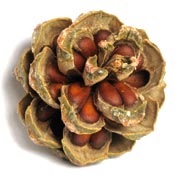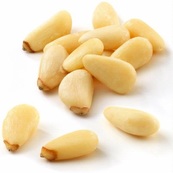To answer queries on pine nuts which we used in the Catalan Pyrenees class, pine nuts are seeds of the pine tree and not actually nuts.
Here is an excerpt from Janet Fletcher, a food writer from the Napa Valley, USA:
Remember those pine cones you used to gather for grade-school crafts projects? Nestled inside their bark-like brackets are the shell-covered seeds, capable of generating another pine tree under the right circumstances.
Every pine tree makes seeds, of course, but only certain varieties produce seeds that are large and tasty enough to eat. In New Mexico, Pinus edulis is the official state tree, producing piñon nuts that are a local delicacy. In Nevada, Arizona, Utah and parts of California, enthusiasts harvest the cones from Pinus monophylla (Nevada's state tree) and claim that its soft-shelled seeds are even tastier than New Mexico piñons.
The Mediterranean pine nut crop, so prized in Greek and Italian cooking, comes primarily from Pinus pinea (in Spain, Portugal and Italy). Pakistan harvests Pinus gerardiana, and in China and Korea, Pinus koraiensis yields edible seeds.
But none of these trees gives up its seeds easily. Harvesters must first gather the cones in the late autumn or early winter in some countries, from wild trees. Europe has pine plantations, but in China, at least, the pines aren't cultivated in orchards like walnuts or hazelnuts. Harvesters pick up fallen cones, clamber up ladders to cut them off, or break them loose with a long-handled hook. Then, typically, the cones are sun-dried or heated to encourage the brackets to open and make their cache more accessible. Depending on the processor, the seeds are then coaxed out by hand or machine, then dried further before processing to remove their hard outer shell. Traders say much of this process is done manually in some countries, which partly explains the nuts' high price.
Here is an excerpt from Janet Fletcher, a food writer from the Napa Valley, USA:
Remember those pine cones you used to gather for grade-school crafts projects? Nestled inside their bark-like brackets are the shell-covered seeds, capable of generating another pine tree under the right circumstances.
Every pine tree makes seeds, of course, but only certain varieties produce seeds that are large and tasty enough to eat. In New Mexico, Pinus edulis is the official state tree, producing piñon nuts that are a local delicacy. In Nevada, Arizona, Utah and parts of California, enthusiasts harvest the cones from Pinus monophylla (Nevada's state tree) and claim that its soft-shelled seeds are even tastier than New Mexico piñons.
The Mediterranean pine nut crop, so prized in Greek and Italian cooking, comes primarily from Pinus pinea (in Spain, Portugal and Italy). Pakistan harvests Pinus gerardiana, and in China and Korea, Pinus koraiensis yields edible seeds.
But none of these trees gives up its seeds easily. Harvesters must first gather the cones in the late autumn or early winter in some countries, from wild trees. Europe has pine plantations, but in China, at least, the pines aren't cultivated in orchards like walnuts or hazelnuts. Harvesters pick up fallen cones, clamber up ladders to cut them off, or break them loose with a long-handled hook. Then, typically, the cones are sun-dried or heated to encourage the brackets to open and make their cache more accessible. Depending on the processor, the seeds are then coaxed out by hand or machine, then dried further before processing to remove their hard outer shell. Traders say much of this process is done manually in some countries, which partly explains the nuts' high price.


